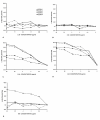Neutralizing and non-neutralizing monoclonal antibodies against dengue virus E protein derived from a naturally infected patient
- PMID: 20132551
- PMCID: PMC2829534
- DOI: 10.1186/1743-422X-7-28
Neutralizing and non-neutralizing monoclonal antibodies against dengue virus E protein derived from a naturally infected patient
Abstract
Background: Antibodies produced in response to infection with any of the four serotypes of dengue virus generally provide homotypic immunity. However, prior infection or circulating maternal antibodies can also mediate a non-protective antibody response that can enhance the course of disease in a subsequent heterotypic infection. Naturally occurring human monoclonal antibodies can help us understand the protective and pathogenic roles of the humoral immune system in dengue virus infection.
Results: Epstein-Barr Virus (EBV) transformation of B cells isolated from the peripheral blood of a human subject with previous dengue infection was performed. B cell cultures were screened by ELISA for antibodies to dengue (DENV) envelope (E) protein. ELISA positive cultures were cloned by limiting dilution. Three IgG1 human monoclonal antibodies (HMAbs) were purified and their binding specificity to E protein was verified by ELISA and biolayer interferometry. Neutralization and enhancement assays were conducted in epithelial and macrophage-like cell lines, respectively. All three HMAbs bound to E from at least two of the four DENV serotypes, one of the HMAbs was neutralizing, and all were able to enhance DENV infection.
Conclusions: HMAbs against DENV can be successfully generated by EBV transformation of B cells from patients at least two years after naturally acquired DENV infections. These antibodies show different patterns of cross-reactivity, neutralizing, and enhancement activity.
Figures







Similar articles
-
Mechanistic study of broadly neutralizing human monoclonal antibodies against dengue virus that target the fusion loop.J Virol. 2013 Jan;87(1):52-66. doi: 10.1128/JVI.02273-12. Epub 2012 Oct 17. J Virol. 2013. PMID: 23077306 Free PMC article.
-
Isolation of dengue virus-specific memory B cells with live virus antigen from human subjects following natural infection reveals the presence of diverse novel functional groups of antibody clones.J Virol. 2014 Nov;88(21):12233-41. doi: 10.1128/JVI.00247-14. Epub 2014 Aug 6. J Virol. 2014. PMID: 25100837 Free PMC article.
-
The potent and broadly neutralizing human dengue virus-specific monoclonal antibody 1C19 reveals a unique cross-reactive epitope on the bc loop of domain II of the envelope protein.mBio. 2013 Nov 19;4(6):e00873-13. doi: 10.1128/mBio.00873-13. mBio. 2013. PMID: 24255124 Free PMC article.
-
The human antibody response to dengue virus infection.Viruses. 2011 Dec;3(12):2374-95. doi: 10.3390/v3122374. Epub 2011 Nov 25. Viruses. 2011. PMID: 22355444 Free PMC article. Review.
-
Modulation of Dengue/Zika Virus Pathogenicity by Antibody-Dependent Enhancement and Strategies to Protect Against Enhancement in Zika Virus Infection.Front Immunol. 2018 Apr 23;9:597. doi: 10.3389/fimmu.2018.00597. eCollection 2018. Front Immunol. 2018. PMID: 29740424 Free PMC article. Review.
Cited by
-
Antibodies against the envelope glycoprotein promote infectivity of immature dengue virus serotype 2.PLoS One. 2012;7(3):e29957. doi: 10.1371/journal.pone.0029957. Epub 2012 Mar 14. PLoS One. 2012. PMID: 22431958 Free PMC article.
-
Liposome-mediated delivery of iminosugars enhances efficacy against dengue virus in vivo.Antimicrob Agents Chemother. 2012 Dec;56(12):6379-86. doi: 10.1128/AAC.01554-12. Epub 2012 Oct 15. Antimicrob Agents Chemother. 2012. PMID: 23070155 Free PMC article.
-
Approaches to Interrogating the Human Memory B-Cell and Memory-Derived Antibody Repertoire Following Dengue Virus Infection.Front Immunol. 2019 Jun 6;10:1276. doi: 10.3389/fimmu.2019.01276. eCollection 2019. Front Immunol. 2019. PMID: 31244836 Free PMC article. Review.
-
Genotype-specific and cross-reactive neutralizing antibodies induced by dengue virus infection: detection of antibodies with different levels of neutralizing activities against homologous and heterologous genotypes of dengue virus type 2 in common marmosets (Callithrix jacchus).Virol J. 2018 Mar 27;15(1):51. doi: 10.1186/s12985-018-0967-x. Virol J. 2018. PMID: 29587780 Free PMC article.
-
Dengue virus infection induces broadly cross-reactive human IgM antibodies that recognize intact virions in humanized BLT-NSG mice.Exp Biol Med (Maywood). 2015 Jan;240(1):67-78. doi: 10.1177/1535370214546273. Epub 2014 Aug 14. Exp Biol Med (Maywood). 2015. PMID: 25125497 Free PMC article.
References
-
- Laoprasopwattana K, Libraty DH, Endy TP, Nisalak A, Chunsuttiwat S, Ennis FA. Antibody-dependent cellular cytotoxicity mediated by plasma obtained before secondary dengue virus infections: potential involvement in early control of viral replication. J Infect Dis. 2007;195(8):1108–16. doi: 10.1086/512860. - DOI - PubMed
-
- Sabin AB. Research on dengue during World War II. Am J Trop Med Hyg. 1952;1(1):30–50. - PubMed
-
- Sangkawibha N, Rojanasuphot S, Ahandrik S, Viriyapongse S, Jatanasen S, Salitul V. Risk factors in dengue shock syndrome: a prospective epidemiologic study in Rayong, Thailand. I. The 1980 outbreak. Am J Epidemiol. 1984;120(5):653–69. - PubMed
-
- Huang KJ, Yang YC, Lin YS, Huang JH, Liu HS, Yeh TM. The dual-specific binding of dengue virus and target cells for the antibody-dependent enhancement of dengue virus infection. J Immunol. 2006;176(5):2825–32. - PubMed
Publication types
MeSH terms
Substances
LinkOut - more resources
Full Text Sources
Other Literature Sources

